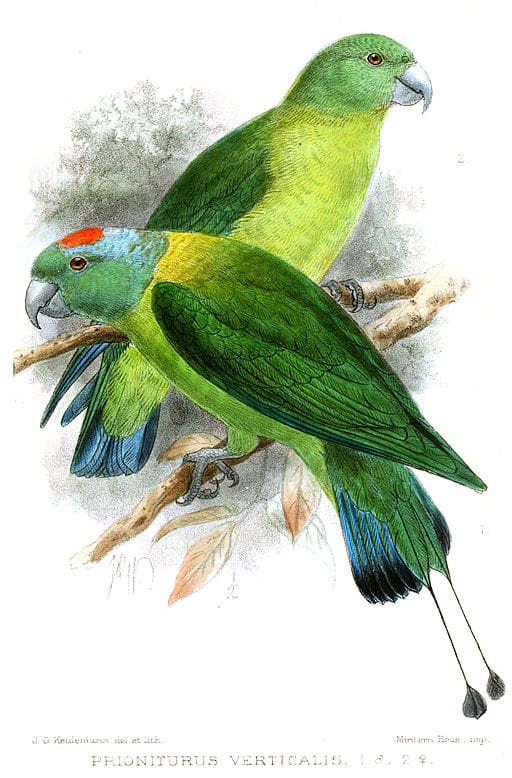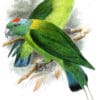Blue-winged Racquet-tailed Parrot
Also known as:
Blue-winged Racquet-tail, Sulu Racquet-tail
Also known as:
Blue-winged Racquet-tail, Sulu Racquet-tail
DID YOU KNOW?
Racquet-tailed parrots are among the least known psittacines in the world.

Prioniturus

verticalis
Size:
35 cm (13.6 in)
Weight:
Not recorded.
Subspecies including nominate:
one
Colour Adult:
Mainly green on back, olive/green on breast and belly. Male-forehead and forecrown pale blue with small red patch; primary feathers blue on outer webs; middle tail feathers green, racquets black tinged blue, side tail feathers green tipped black. Beak blue/grey. Female-as in male but with no red spot on head.
Colour Juvenile:
As in female but with shorter tail shafts.
Call:
Varied call sounds include harsh, rasping notes, squeaky and disyllabic notes.
More Information:
Content Sources:
CITES
BirdLife International
Cornell Lab of Ornithology/Birds of the World
A Guide to Parrots of the World, Juniper and Parr, 1998
Vanished and Vanishing Parrots, Forshaw, 2017.
Parrots: Status Survey and Conservation Plan 2000-2004, Snyder, McGowan, Gilardi and Grajal, 2000.
Parrots of the World, Forshaw and Cooper, 1989.
Parrots of the World, Forshaw, 2006.
Captive Status:
Unknown in captivity.
Longevity:
—
Housing:
—
Diet:
—
Enrichment:
—
Nest Box Size:
—
Clutch Size:
Not recorded.
Fledging Age:
—
Hatch Weight:
—
Peak Weight:
—
Weaning Weight:
—
World Population:
75-375 individuals, declining rapidly.
IUCN Red List Status:
Critically Endangered
CITES Listing:
Appendix II
Threat Summary:
Restricted-range species, confined to the Sulu archipelago Endemic Bird Area. Almost no forest remains on the islands of Sibutu and Sanga-sanga; species is suspected to be extinct on the latter. As habitat continues to be lost, the rate of decline is thought to be accelerating.
Is shot for target practice on Tawi-Tawi.
Range:
Tawi-Tawi and possibly Sibutu, Southwestern Sulu Archipelago, S Philippine Islands.
Habitat:
Occurs in lowland forest, forest edge, mangroves and dense remnant forest patches.
Wild Diet:
Feeds in upper canopy of fruiting trees.
Ecology and Behaviour:
Birds seen in singles or pairs in high flight over canopy; noisy in flight, but difficult to detect while feeding. Very active at sunrise.
Clutch and Egg Size:
Not recorded.
Breeding Season:
September-January. Nest recorded in a large broken-off palm tree.
Related Links:
—

